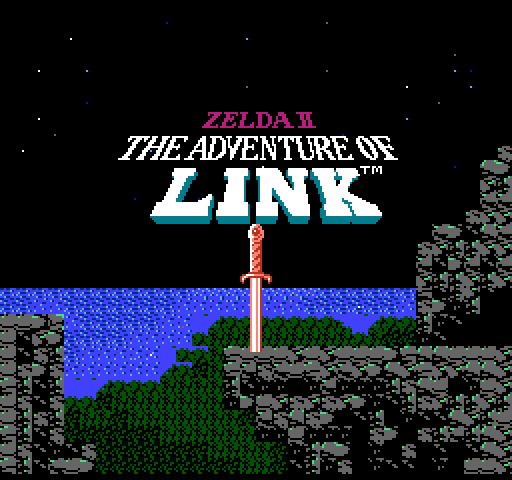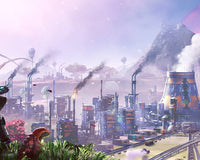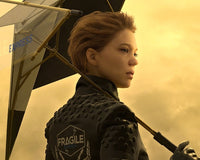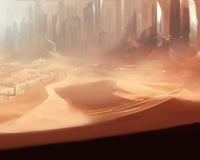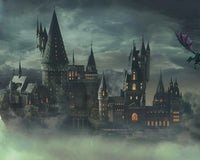 Zelda II is pretty different to the original Zelda game; the original is a top-down action-adventure game with strong emphasis on puzzle-solving. This game is a side-scrolling action-adventure with more focus on the combat. The gameplay shift for this game is pretty dramatic and several features of the first game are no longer as important such as the puzzles. Zelda II is focused on combat and has strong RPG elements.
Zelda II is pretty different to the original Zelda game; the original is a top-down action-adventure game with strong emphasis on puzzle-solving. This game is a side-scrolling action-adventure with more focus on the combat. The gameplay shift for this game is pretty dramatic and several features of the first game are no longer as important such as the puzzles. Zelda II is focused on combat and has strong RPG elements.
 It has the player travel across the land to prevent the return the evil Ganon by returning the six shards of magic to the six temples; he can then enter the labyrinth and reclaim the lost Triforce of Courage in order to stop Ganon's loyal minions from resurrecting him. Zelda is also in trouble and Link is the only one able to save her; she has been afflicted with a coma nd cannot be woken up by normal means. The main place to find the story however is not in the game but in the manual, very few characters in the game mention anything about the plot and there is no information in the game itself about why Zelda is unconscious. Most of the dialogue with the town citizens is not too helpful either however they do hint towards the plot sometimes.
It has the player travel across the land to prevent the return the evil Ganon by returning the six shards of magic to the six temples; he can then enter the labyrinth and reclaim the lost Triforce of Courage in order to stop Ganon's loyal minions from resurrecting him. Zelda is also in trouble and Link is the only one able to save her; she has been afflicted with a coma nd cannot be woken up by normal means. The main place to find the story however is not in the game but in the manual, very few characters in the game mention anything about the plot and there is no information in the game itself about why Zelda is unconscious. Most of the dialogue with the town citizens is not too helpful either however they do hint towards the plot sometimes.
The game is played on a birds-eye view of the overworld where the player must travel to their destination; finding enemies will cause the game to go into a side-scrolling battle against the enemies once they reach the player on the map. The player can watch enemies approach and follow them on the map with the birds-eye view mechanic. Battles will differ depending on the enemy type and also the terrain the player is one; the layout of the battleground will be different each time. The player can travel across various terrains to get to their destination and some locations are difficult to find as they require using hidden passages, detailed searching or using a key found in an earlier area.
Towns can be found across the map and these are zones where the player can heal, learn new spells and find game hints; finding the important people and items in the town can be difficult with the side-scrolling view. The side-scrolling view is a much bigger problem for the Labyrinth and it feels a little awkward for this part of the game however this view works well for the puzzles and also the combat.
Dealing with enemies on the side-scrolling screens can be a little tricky however the combat system itself is good; Link can attack while standing, when crouched and with various aerial attacks and the enemies can use the same attack manoeuvres as well. This can also lead to duels with some of the enemies which can be more challenging; the shielded enemies are notably more difficult and prone to starting duels with the player. Combat is certainly the strongest point for Zelda II and bosses are also entertaining, some of them are rather difficult to deal with. The boss battles have a puzzle aspect to them which makes then much harder; the player must focus on making the well-times jumps and attacks while also finding the bosses weakness and the player also needs the reflexes to hit them in time. Some of the puzzles will require the player to use the Jump Spell in order to leap over the boss or to avoid their attacks; getting boss battles right can be challenging at first. It all resolves around timing and knowledge about the boss.
The boss battles have a puzzle aspect to them which makes then much harder; the player must focus on making the well-times jumps and attacks while also finding the bosses weakness and the player also needs the reflexes to hit them in time. Some of the puzzles will require the player to use the Jump Spell in order to leap over the boss or to avoid their attacks; getting boss battles right can be challenging at first. It all resolves around timing and knowledge about the boss.
There are various RPG elements in Zelda II which are new to the series. One of the biggest features is that Link earns experience points and levels up in three areas: attack strength, hit points defense and magic power. Experience is gained by defeating enemies and by locating the hidden XP bags. Once enough experience has been gained, the player is able to select which of the three attributes they want to level up; it gives the player a lot of combat style choice and doesn't force the player to level into any attribute they don't want.
Graphics wise, the game looks good however Zelda II lacks some of the bright colors seen in the first game. The game is more detailed and enemies stand in a much more realistic way; enemies use color schemes to indicate their strength and also stand out enough against the backgrounds which makes battles much easier. The enemies are not supposed to be camouflaged and each palace in the game also uses a different color scheme. There are new music tracks with a few tracks from the first game; the variety is nice and the music is good, some of the tracks may even better than the ones seen in the first game.
Zelda II: Legend of Link is very different to the first Zelda game and it certainly doesn't deserve all of the “black sheep” references about it; the side-scrolling view works well for combat and the combat is the highlight of the game. Despite its RPG elements, the story is rather weak and is mostly found in the game manual. The game is good and entertaining to play, it just wasn't what fans were expecting to be the sequel to the original ground breaking Zelda game. Zelda II is worth playing for the fun combat and boss battles at the very least and Zelda fans should keep an open mind with the new gameplay.
Check to see if we have it in stock!
